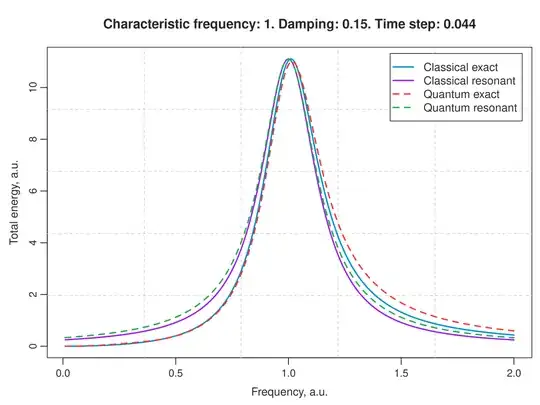I have solved two related problems and have some questions about the results.
- Forced classical oscillator with the following equation:
$$\ddot{x}+\omega_{0}^{2}x=\varepsilon e^{-\gamma t}\sin\omega t,\qquad x\left(0\right)=0,\qquad\dot{x}\left(0\right)=0.$$
- Quantum two-state system, derived from harmonic oscillator 0 and 1 states with the same force acting as a perturbation:
$$\left[\begin{array}{c} \dot{C}_{1}\\ \dot{C}_{2} \end{array}\right]=-ie^{-\gamma t}\sin\omega t\left[\begin{array}{cc} 0 & \Omega e^{-i\omega_{0}t}\\ \Omega e^{i\omega_{0}t} & 0 \end{array}\right]\left[\begin{array}{c} C_{1}\\ C_{2} \end{array}\right],$$
$$\Psi = C_1 \psi_0 + C_2 \psi_1,\qquad C_1(0)=1,\qquad C_2(0)=0,$$
$$\hbar \omega_0 = E_1-E_0,\qquad \Omega=\frac{m\varepsilon}{\hbar}\left\langle \psi_{0}\right|x\left|\psi_{1}\right\rangle = \sqrt {\frac{m\varepsilon^{2}}{2\hbar\omega_{0}}}. $$
The exact solutions are long, so instead I'll show approximate results for the quantity I was interested in.
The total energy transferred to the system from time $t=0$ to time $t\to +\infty$ under the condition $|\omega-\omega_0| \ll \omega_0$ and $\gamma \ll \omega_0$.
$$E_{cl}=\lim_{t \to \infty} \left(\frac{m\dot{x}^2}{2}+\frac{m \omega_0^2 x^2}{2} \right) = \frac{m\varepsilon^{2}}{8\left[\left(\omega-\omega_{0}\right)^{2}+\gamma^{2}\right]}$$
$$E_{q} = \lim_{t \to \infty} \hbar \omega_0 \left|C_2 \right|^2=\frac{\Omega^{2}\hbar\omega_{0}}{4\left[\left(\omega-\omega_{0}\right)^{2}+\gamma^{2}\right]}= \frac{m\varepsilon^{2}}{8\left[\left(\omega-\omega_{0}\right)^{2}+\gamma^{2}\right]}$$
In other words, I obtained exactly the same result, under the assumptions stated above.
What I wanted to ask, does this make sense physically? I know that two level system is kind of the quantum version of a simple oscillator, or we could even say that I was solving the actual quantum harmonic oscillator, but only restricted myself to two levels because of the resonance condition. Still, it was surprising to me that I obtained the exact same formula.
I'm also going to compare the exact solutions, but the quantum case is very hard to solve exactly.
Edit: I did some numerical calculations. For the quantum two-level system the $E(\omega)$ dependence looks very similar to the classical oscillator, but not the same.
"Resonant" means the approximation $|\omega-\omega_0|\ll\omega_0$ in both cases. The time step seems large, but I used an implicit 4th order scheme, so it's pretty accurate. Just to clarify, I used numerical integration for the two-level system, both exact and approximate. For classical system I used the actual exact solution.
